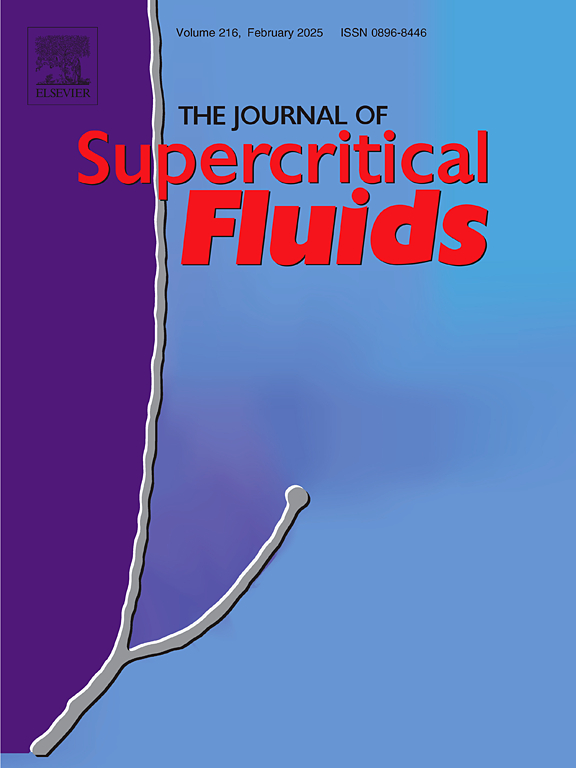超临界co2萃取莳萝籽精油:含有豌豆蛋白及抗真菌活性乳剂的研制
IF 4.4
3区 工程技术
Q2 CHEMISTRY, PHYSICAL
引用次数: 0
摘要
本研究评估了超临界CO2 (scCO2)萃取莳萝籽精油、植物蛋白乳化液的形成,并测定了它们的抗真菌活性。在40-60°C和150-350 bar条件下提取,在350 bar和50°C条件下提取率最高(13.69 %)。将初始种子质量放大3倍和10倍,动力学模型成功拟合实验数据。此外,利用高强度超声(HIUS)以莳萝油提取物和豌豆和扁豆分离蛋白为天然乳化剂形成乳化液。与高速均质相比,HIUS(1200 W/1 min)产生的乳液更小,更稳定,豌豆蛋白的稳定性优于扁豆蛋白。乳剂对小麦病原菌禾枯菌(Fusarium graminearum)和小麦白腐菌(Pyrenophora tritrii -repentis)的抑制作用最低浓度分别为1.00 µL/mL和0.25 µL/mL。莳萝提取物中含有丰富的香芹酮,具有较高的抗真菌活性,具有作为小麦天然抗真菌剂的潜力。本文章由计算机程序翻译,如有差异,请以英文原文为准。
Supercritical CO₂ extraction of essential oil from dill seeds: Development of emulsions with pea protein and antifungal activity
This study evaluated supercritical CO2 (scCO2) extraction of essential oil from dill seeds, emulsion formation with plant-based proteins, and determination of their antifungal activity. Extractions were performed at 40–60 °C and 150–350 bar, with maximum yield (13.69 %) achieved at 350 bar and 50 °C. Scaling up the initial seed mass by three and ten times, kinetic models successfully fit the experimental data. In addition, high-intensity ultrasound (HIUS) was used to form an emulsion with dill oil extracts and pea and lentil protein isolates as natural emulsifiers. HIUS (1200 W/1 min) produced smaller, more stable emulsions compared to high-speed homogenization, with pea protein outperforming lentil protein in stability. The emulsions inhibited Fusarium graminearum and Pyrenophora tritici-repentis, wheat pathogens, with minimum inhibitory concentrations of 1.00 µL/mL and 0.25 µL/mL, respectively. Dill extracts rich in carvone showed high antifungal efficacy, emphasizing their potential as natural antifungal agents for wheat protection.
求助全文
通过发布文献求助,成功后即可免费获取论文全文。
去求助
来源期刊

Journal of Supercritical Fluids
工程技术-工程:化工
CiteScore
7.60
自引率
10.30%
发文量
236
审稿时长
56 days
期刊介绍:
The Journal of Supercritical Fluids is an international journal devoted to the fundamental and applied aspects of supercritical fluids and processes. Its aim is to provide a focused platform for academic and industrial researchers to report their findings and to have ready access to the advances in this rapidly growing field. Its coverage is multidisciplinary and includes both basic and applied topics.
Thermodynamics and phase equilibria, reaction kinetics and rate processes, thermal and transport properties, and all topics related to processing such as separations (extraction, fractionation, purification, chromatography) nucleation and impregnation are within the scope. Accounts of specific engineering applications such as those encountered in food, fuel, natural products, minerals, pharmaceuticals and polymer industries are included. Topics related to high pressure equipment design, analytical techniques, sensors, and process control methodologies are also within the scope of the journal.
 求助内容:
求助内容: 应助结果提醒方式:
应助结果提醒方式:


